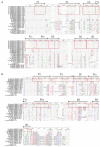Development of a loop-mediated isothermal amplification assay for the rapid detection of Russula subnigricans and Russula japonica
- PMID: 36081806
- PMCID: PMC9445624
- DOI: 10.3389/fmicb.2022.918651
Development of a loop-mediated isothermal amplification assay for the rapid detection of Russula subnigricans and Russula japonica
Abstract
Russula subnigricans is the only deadly species in the genus Russula with a mortality rate of more than 50%, and Russula japonica is the most common poisonous species, making rapid species identification in mushroom poisoning incidents extremely important. The main objective of this study was to develop a rapid, specific, sensitive, and simple loop-mediated isothermal amplification (LAMP) assay for the detection of R. subnigricans and R. japonica. Two sets of species-specific LAMP primers targeting internal transcribed spacer (ITS) regions were designed to identify R. subnigricans and R. japonica. The results demonstrated that while LAMP could specifically detect R. subnigricans and R. japonica, the polymerase chain reaction (PCR) could not distinguish R. subnigricans from Russula nigricans. In addition, the results demonstrated that, compared to electrophoresis-LAMP and real-time quantitative LAMP (RT-qLAMP), the detection sensitivity of HNB-LAMP (a mixture of LAMP with hydroxy naphthol blue (HNB) dye) for R. subnigricans could reach 0.5 pg/μl and was 100-fold higher than that of PCR. The LAMP reaction could be completed in 45 min, which is much faster than the conventional PCR. In the future, LAMP can be used a quick, specific, and sensitive detection tool in various fields.
Keywords: ITS; Russula japonica; Russula subnigricans; loop-mediated isothermal amplification; mushroom poisoning.
Copyright © 2022 Long, Jiang, He and Chen.
Conflict of interest statement
The authors declare that the research was conducted in the absence of any commercial or financial relationships that could be construed as a potential conflict of interest.
Figures









Similar articles
-
Rapid Russula senecis identification assays using loop-mediated isothermal amplification based on real-time fluorescence and visualization.Appl Microbiol Biotechnol. 2022 Feb;106(3):1227-1239. doi: 10.1007/s00253-022-11774-9. Epub 2022 Jan 24. Appl Microbiol Biotechnol. 2022. PMID: 35072734
-
A Loop-Mediated Isothermal Amplification Assay Utilizing Hydroxy Naphthol Blue (LAMP-HNB) for the Detection of Treponema pallidum Subspp. pallidum.Pathogens. 2024 Oct 31;13(11):949. doi: 10.3390/pathogens13110949. Pathogens. 2024. PMID: 39599503 Free PMC article.
-
Hemolysis associated with Russula subnigricans ingestion in a patient with glucose-6-phosphate dehydrogenase deficiency.Clin Toxicol (Phila). 2023 Jun;61(6):473-475. doi: 10.1080/15563650.2023.2220899. Epub 2023 Jun 13. Clin Toxicol (Phila). 2023. PMID: 37310153
-
Research progress of loop-mediated isothermal amplification in the detection of Salmonella for food safety applications.Discov Nano. 2024 Aug 6;19(1):124. doi: 10.1186/s11671-024-04075-9. Discov Nano. 2024. PMID: 39105889 Free PMC article. Review.
-
Recent advances in population genetics of ectomycorrhizal mushrooms Russula spp.Mycology. 2015 Jun 24;6(2):110-120. doi: 10.1080/21501203.2015.1062810. eCollection 2015. Mycology. 2015. PMID: 30151319 Free PMC article. Review.
Cited by
-
Morphological Characteristics and Molecular Evidence Reveal four New Species of Russula subg. Brevipedum from China.J Fungi (Basel). 2022 Dec 30;9(1):61. doi: 10.3390/jof9010061. J Fungi (Basel). 2022. PMID: 36675882 Free PMC article.
References
-
- Adamčík S., Looney B., Cabon M., Jančovičová S., Adamčíková K., Avis P. G., et al. . (2019). The quest for a globally comprehensible Russula language. Fungal Divers. 99, 369–449. 10.1007/s13225-019-00437-2 - DOI
-
- Baek Y. H., Um J., Antigua K. J. C., Parket J., Kim Y., Oh S., et al. . (2020). Development of a reverse transcription-loop-mediated isothermal amplification as a rapid early-detection method for novel SARS-CoV-2. Emerg. Microbes. Infect. 9, 998–1007. 10.1080/22221751.2020.1756698 - DOI - PMC - PubMed
-
- Barreda-García S., Miranda-Castro R., de-Los-Santos-Álvarez N., Miranda-Ordieres A. J., Lobo-Castañón M. J. (2018). Helicase-dependent isothermal amplification: a novel tool in the development of molecular-based analytical systems for rapid pathogen detection. Anal. Bioanal. Chem. 410, 679–693. 10.1007/s00216-017-0620-3 - DOI - PMC - PubMed
-
- Buyck B., Zoller S., Hofstetter V. (2018). Walking the thin line… ten years later: the dilemma of above- versus below-ground features to support phylogenies in the Russulaceae (Basidiomycota). Fungal Divers. 89, 267–292. 10.1007/s13225-018-0397-5 - DOI
-
- Chen G. F., Ma C. S., Zhang C. Y., Zhou J., Wang Y. Y., Wang G. C., et al. . (2013). A rapid and sensitive method for field detection of Prorocentrum donghaiense using reverse transcription-coupled loop-mediated isothermal amplification. Harmful Algae 29, 31–39. 10.1016/j.hal.2013.08.001 - DOI
LinkOut - more resources
Full Text Sources

